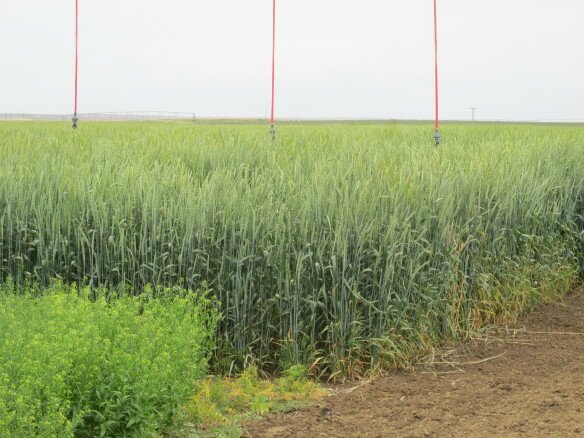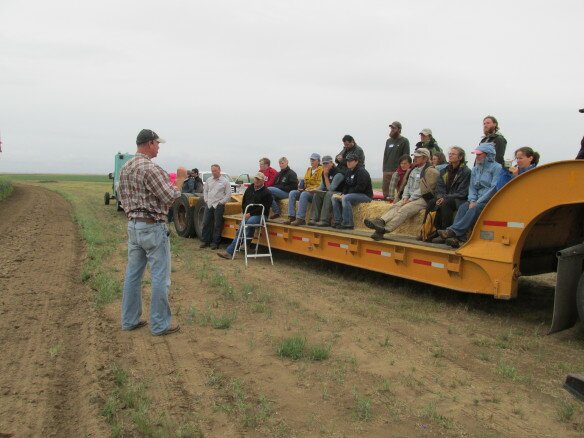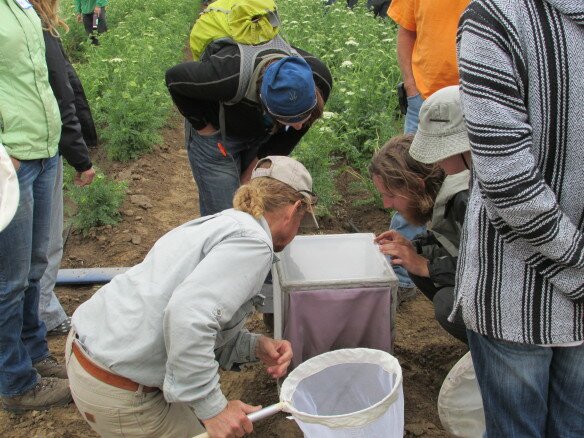Integrated Approaches to Pest Management: Farmscaping for Beneficials in Washington’s Columbia Basin
 In Franklin County, on an uncharacteristically cool day for late June, 38 people came out to Lenwood Farms near Connell for a farm walk in Farmscaping for Beneficials in the Columbia Basin. Brad Bailie guided a tour of this large and diverse property, explaining his methods and strategies for growing certified organic crops on the 600-acre farm. Supported by the expertise of Gwendolyn Ellen from OSU’s Farmscaping for Beneficials Project at the Integrated Plant Protection Center, and etymologist Terry Miller, Brad talked about the insect populations on the farm and how his practices help to keep a balance. The plantings we discussed also demonstrated habitat restoration and soil conservation.
In Franklin County, on an uncharacteristically cool day for late June, 38 people came out to Lenwood Farms near Connell for a farm walk in Farmscaping for Beneficials in the Columbia Basin. Brad Bailie guided a tour of this large and diverse property, explaining his methods and strategies for growing certified organic crops on the 600-acre farm. Supported by the expertise of Gwendolyn Ellen from OSU’s Farmscaping for Beneficials Project at the Integrated Plant Protection Center, and etymologist Terry Miller, Brad talked about the insect populations on the farm and how his practices help to keep a balance. The plantings we discussed also demonstrated habitat restoration and soil conservation.
In the heritage garden near the farm entrance, Heather Wendt of the Franklin County Conservation District described the support her agency provides, and the benefits of using local native plants. She encouraged buying native plants from local nurseries and advised placing orders ahead of time for bulk quantities. Local native plants will survive the climate of the region, and when used in a heritage garden, provide a learning model near the farm office. Such native plants also provide genetic material (from seeds to divisions) for other areas on the farm.
 Two trailers with hay bale seats carried eager participants to many areas of the property, where we observed farm features and engaged in hands-on activities of insect scouting and identification. Located in non-plowed areas, beetle banks provide habitat for beetles on the farm, which eat weed seeds in abundance, and which breed inside the bank to provide renewed populations each year. Gwendolyn described techniques of insect capture using aspirators and nets which sweep the air just above the carrot seed crop, where the flower heads open to all insects. The flowers attract the beneficial insects which eat the pests. Carrot seed pest damage can reduce germination rates and the income received from the crop. We observed the ratio of pests to beneficial insects we caught and placed in a collection box at the field edge. Participants seemed to enjoy immensely the activity and lessons learned.
Two trailers with hay bale seats carried eager participants to many areas of the property, where we observed farm features and engaged in hands-on activities of insect scouting and identification. Located in non-plowed areas, beetle banks provide habitat for beetles on the farm, which eat weed seeds in abundance, and which breed inside the bank to provide renewed populations each year. Gwendolyn described techniques of insect capture using aspirators and nets which sweep the air just above the carrot seed crop, where the flower heads open to all insects. The flowers attract the beneficial insects which eat the pests. Carrot seed pest damage can reduce germination rates and the income received from the crop. We observed the ratio of pests to beneficial insects we caught and placed in a collection box at the field edge. Participants seemed to enjoy immensely the activity and lessons learned.
 In corners where irrigation does not reach, Brad plants perennial shrubs which provide currants, berries and habitat for wildlife and beneficial insects. These are effective for soil conservation but present challenges for weed management. This habitat revealed another diverse population of beneficials. David Granatstein of WSU’s Center for Sustaining Agriculture and Natural Resources (CSANR) asked us to consider how far and when the beneficial insects travel into the row crops to provide their beneficial services. He compared orchard fruit crops which send plant chemical signals that attract beneficials. These issues in row crops need further study and Lenwood Farm is providing the impetus and format for such queries.
In corners where irrigation does not reach, Brad plants perennial shrubs which provide currants, berries and habitat for wildlife and beneficial insects. These are effective for soil conservation but present challenges for weed management. This habitat revealed another diverse population of beneficials. David Granatstein of WSU’s Center for Sustaining Agriculture and Natural Resources (CSANR) asked us to consider how far and when the beneficial insects travel into the row crops to provide their beneficial services. He compared orchard fruit crops which send plant chemical signals that attract beneficials. These issues in row crops need further study and Lenwood Farm is providing the impetus and format for such queries.
 Brad showed us wind break and habitat hedgerows, as well as fields of ancient grains: farro, spelt, emmer and black Nile barley. He described the pros and cons of self-seeding annual alyssum, using drip irrigation, and the timing and costs hand-weeding. Lenwood Farms takes great effort to enhance the landscape using organic and innovative methods. At the end of the farm walk Brad and his wife Esther Daza treated participants to a meal made from ancient grains and local vegetables from Cloudview EcoFarm prepared by chef Richard Kitos, from the Ivy Wild Inn. Eco-Depot described the solar system in the new shop which housed us from the rain. This farm walk covered many aspects of farm operations that show commitment and intent to innovate for success.
Brad showed us wind break and habitat hedgerows, as well as fields of ancient grains: farro, spelt, emmer and black Nile barley. He described the pros and cons of self-seeding annual alyssum, using drip irrigation, and the timing and costs hand-weeding. Lenwood Farms takes great effort to enhance the landscape using organic and innovative methods. At the end of the farm walk Brad and his wife Esther Daza treated participants to a meal made from ancient grains and local vegetables from Cloudview EcoFarm prepared by chef Richard Kitos, from the Ivy Wild Inn. Eco-Depot described the solar system in the new shop which housed us from the rain. This farm walk covered many aspects of farm operations that show commitment and intent to innovate for success.
Summary by Jacqueline Cramer
Funding for this farm walk and other Tilth Producers educations programs are funded in part by the USDA Beginning Farmers and Ranchers Development Program.
Farm Walk booklet: HERE



